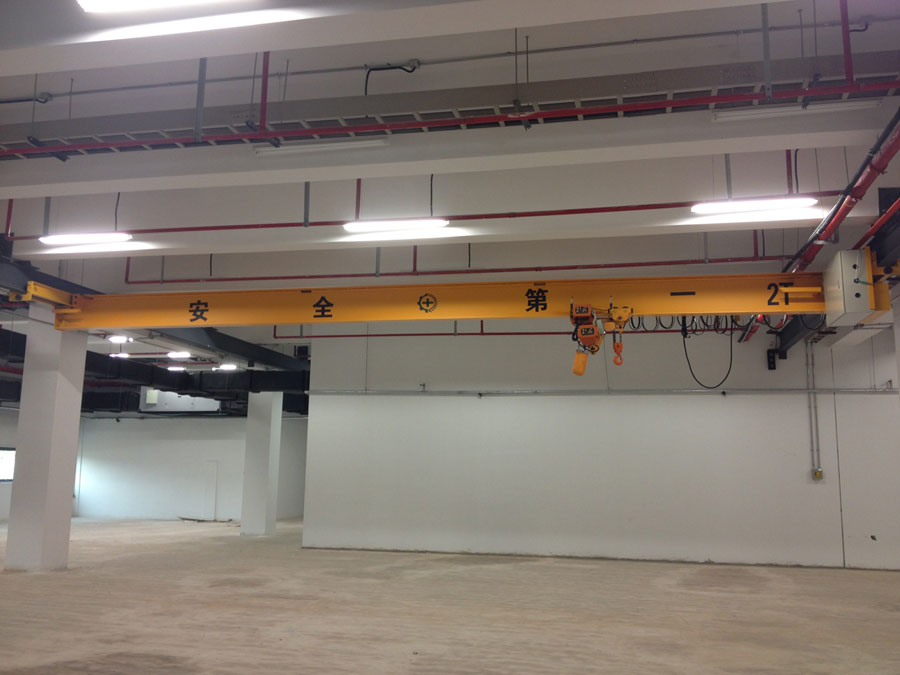Precautions and Troubleshooting Methods for Installing Suspended Overhead Cranes
In a market with many crane choices, how to choose a perfect crane is quite vital. For different environments, the choice of crane is also different. For the different needs, the choice of crane is of great importance. After understanding the performance of the relevant crane, the choice will be much more correct.
In order not to affect the operation, if a workshop does not allow any supporting structure, the suspended single girder overhead crane is a perfect choice. The crane system requires that the roof structure bear enough strength to support the crane load safely. Customers can install multiple main beams on sets of fixed rails, which improves production efficiency. This type of product is a steel structure with a bearing capacity of 75-2000kg, and the total length of the main beam can reach 10m. Compared with the traditional single-girder crane, the design and loading and unloading of the closed track only need one-third of the force. The design of the truss track allows for larger spans and more flexible installation arrangements.
Suspended single-girder cranes are easy to install, reducing installation time and costs. It increases operator satisfaction, enables a safe work environment, and delivers a quick return on investment through increased productivity. Comparatively, we design for light loads (up to 2000kg), parts assembly, machining, palletizing, injection molding, storage, loading and unloading, process equipment maintenance, and truck service centers.

However, single-girder suspension cranes often have problems - torsion and asynchronous operation, which make the crane unable to operate normally, easily cause damage to the suspension wheelset and I-beam rail, and bring hidden dangers to safety production. This paper discusses the causes and solutions of the twisted wire problem.
Single girder crane torsion
The starting and braking of the suspension crane is realized by the friction between the driving wheel and the I-beam rail. If the friction force of the drive wheels on both sides of the crane end beam is inconsistent, the crane will inevitably swing. According to the different twisting phenomenon, analyze its causes and solutions.
No twist at the beginning, no twist at the end.
When there is no obvious torsional vibration when starting and running, but there is obvious torsional vibration at stop, attention should be paid to the rotation and torsion of the driving wheel on the swing side. It can be concluded that this is the brake caused by the inconsistency of the two sides. When starting, the motor starts synchronously without torque swing. If the drive wheel doesn't turn with the twist, it's not a braking problem, it's a suspension problem on the drive wheel side.
Start and stop swinging
There are two kinds of torque when starting and stopping: one side of the motor is damaged and the brake fails; the other end of the beam has too little friction or hangs in the air. Motor damage and brake failure can be resolved by replacing or repairing the motor and adjusting the brake. There are two cases of start-stop torque caused by the suspension of the driving wheel: one is the uneven installation of the lower flange of the I-beam, so that the distance between the I-beam rail surface and the end beam driving wheel cannot be effectively contacted; the other is the deviation of the I-beam itself. If the deviation causes one side of the internal gear to be too large, it happens to be the side where the drive wheel runs, which will also result in poor contact between the drive wheel and the tread of the I-beam track. In either case, the drive wheels must not touch the surface of the I-beam track during starting.
The drive wheels turn but cannot drive efficiently, causing lag. When the other side walks a certain distance, the sliding side is driven to walk. When parking, the driving wheel on the sliding side has stopped rotating, but the driving wheel for braking has poor contact with the tread of the I-beam track, and the friction is insufficient. If the drive wheel continues to move forward under the action of inertia, twisting will still occur. Therefore, the key to solving the torsion problem is to make the drive wheel effectively contact the I-beam track.
The following points should be paid attention to when installing suspended cranes:
1. The flatness and design elevation deviation of the connecting surface of the I-beam rail hanger and the I-beam rail shall be controlled within the specified range.
2. Check the selected I-beam track. The track size should meet the track requirements. At the same time, the height difference between the I-beam track and the interval should conform to the GB 50278-1998 standard. Excessive height difference of the same section will also lead to poor contact on the same side of the end beam driving wheel, resulting in slippage and torsion.
3. After the I-beam rail is installed, check the flatness of the lower flange of the I-beam.
4. The driving device of the cart should be installed on the internal gear of the crane, which will help reduce the possibility of torsional vibration of the bridge due to deformation under load or after a period of use.
5. If there is no problem with the design of the suspended crane put into use after installation, when the whole stroke or part of the crane is still torsion, the spacer can be added. The thickness of the pad should be 0.5-3 mm, and the pad should be placed between the I-steel tread flange on the other side of the suspension of the driving wheel and the connecting plate of the support. Secure the gasket by spot welding or other means.
If you have any inquiry about suspended overhead crane,please don’t hesitate to contact us.
 info@dejunindustry.com
info@dejunindustry.com +86 13721448067
+86 13721448067




